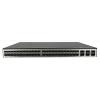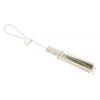-
€

Huawei CloudEngine 6863 series switches are next-generation 25GE access switches that provide high performance and high port density on data center networks and high-end campus networks. The CloudEngine 6863 series have advanced hardware architecture with 40GE/100GE uplink ports and high-density 25GE access ports. Using Huawei's VRP8 software platform, CloudEngine 6863 series switches support extensive data center features and high stacking capabilities. In addition, the CloudEngine 6863 series use a flexible airflow design (front-to-back or back-to-front). CloudEngine 6863 series can work with CloudEngine 16800 or CloudEngine 12800 series data center core switches to build elastic, virtual, and high-quality 40GE/100GE full-mesh networks, meeting requirements of cloud computing data centers. CloudEngine 6863 series provide high-density 25GE access to help enterprises and carriers build a scalable data center network platform in the cloud computing era. They can also work as core or aggregation switches on campus networks.
High-Density 25GE Access
CloudEngine 6863 series provide up to 48 x 25GE ports, allowing for high-density 10GE/25GE server access and smooth evolution. CloudEngine 6863 series provide up to 6 x 100GE QSFP28 ports. Each QSFP28 port can also be used as one 40GE QSFP+ port, providing flexibility in networking. The uplink 40GE/100GE ports can be connected to CloudEngine 16800 or CloudEngine 12800 series switches to build a non-blocking network platform.
Inter-device Link Aggregation, High Efficiency and Reliability
CloudEngine 6863 series support multi-chassis link aggregation group (M-LAG), which enables links of multiple switches to aggregate into one to implement device-level link backup. Switches in an M-LAG all work in active state to share traffic and back up each other, enhancing system reliability. Switches in an M-LAG can be upgraded independently. During the upgrade, other switches in the system take over traffic forwarding to ensure uninterrupted services. M-LAG supports dual-homing to Ethernet, VXLAN, and IP networks, allowing for flexible networking.
ESI Multi-homing Access
CloudEngine 6863 series support RFC-compliant EVPN multi-homing solution. The Ethernet Segment Identifier (ESI) is used to expand EVPN VXLAN gateways from active-active mode to multi-active mode. EVPN VXLAN gateways can work in activeactive mode to implement multi-homing access of servers (servers can be quad-homed to EVPN VXLAN gateways).
Virtualized Hardware Gateway, Enabling Quick Deployment
CloudEngine 6863 series can connect to a cloud platform through open APIs, facilitating unified management of virtual and physical networks. CloudEngine 6863 series can work with the industry's mainstream virtualization platforms. The virtualization function protects investments because services can be deployed quickly without requiring network changes. The hardware gateway deployment enables fast service deployment without changing the customer network, providing investment protection. CloudEngine 6863 series support Border Gateway Protocol - Ethernet VPN (BGP-EVPN), which can run as the VXLAN control plane to simplify VXLAN configuration within and between data centers.
Standard Interfaces, Enabling Openness and Interoperability
CloudEngine 6863 series support NETCONF and can work with Huawei iMaster NCE-Fabric. CloudEngine 6863 series support Ansible-based automatic configuration and open-source module release, expanding network functions and simplifying device management and maintenance. CloudEngine 6863 series can be integrated into mainstream SDN and cloud computing platforms flexibly and quickly.
ZTP, Implementing Automatic O&M
CloudEngine 6863 series support Zero Touch Provisioning (ZTP). ZTP enables the CloudEngine 6863 series to automatically obtain and load version files from a USB flash drive or file server, freeing network engineers from onsite
configuration and deployment. ZTP reduces labor costs and improves device deployment efficiency. ZTP provides built-in scripts through open APIs. Data center personnel can use a programming language they are familiar with, such as Python, to centrally configure network devices. ZTP decouples the configuration time of new devices from the device quantity and area distribution, which improves service provisioning efficiency.
FabricInsight-based Intelligent O&M
The CloudEngine 6863 provides telemetry technology to collect device data in real time and send the data to Huawei data center network analyzer iMaster NCE-FabricInsight. The iMaster NCE-FabricInsight analyzes network data based on the intelligent fault identification algorithm, accurately displays the real-time network status, effectively demarcates and locates faults in a timely manner, and identifies network problems that affect user experience, accurately guaranteeing user experience.
iMaster NCE-based Simplified Network Deployment
CloudEngine 6863 series switches can interconnect with iMaster NCE-Fabric through standard protocols such as NetConf and SNMP to implement network automatic management and control, providing more efficient and intelligent operation methods, simplifying network management, and reducing the OPEX.
Flexible Airflow Design, Improving Energy Efficiency
Flexible front-to-back or back-to-front airflow design
- CloudEngine 6863 series use a strict front-to-back or back-to-front airflow design that isolates cold air channels from hot air channels. This design improves heat dissipation efficiency and meets design requirements of data center equipment rooms.
- Air can flow from front to back or back to front depending on the fans and power modules that are used.
- Redundant power modules and fans can be configured to ensure service continuity
Innovative energy-saving technologies
- CloudEngine 6863 series have innovative energy-saving chips and can measure system power consumption in real time. The fan speed can be adjusted dynamically based on system consumption. These energy-saving technologies reduce O&M costs and contribute to a greener data center.
Clear Indicators, Simplifying Maintenance
Clear indicators
- Port indicators clearly show the port status and port rate. The 100GE port indicators can show the states of all ports derived from the 100GE ports.
- State and stack indicators on both the front and rear panels enable users to maintain the switch from either side.
- CloudEngine 6863 series support remote positioning. Remote positioning indicators enable users to easily identify the switches they want to maintain in an equipment room full of devices.
Simple maintenance
- The management port, fans, and power modules are on the front panel, which facilitates device maintenance.
- Data ports are located at the rear, facing servers. This simplifies cabling.
Specifications
| CE6863E-48S6CQ AC | |
| Hardware features | |
|---|---|
| 10/25GE SFP28 ports | 48 |
| 40/100GE QSFP28 ports | 6 |
| Dimensions (W x D x H) | 442 mm x 420 mm x 43.6 mm |
| Weight (excluding optical transceivers, power modules, and fan assemblies/including AC power modules and fan assemblies, excluding optical transceivers, kg) |
5,7 / 7,8 kg |
| Switching capacity (Tbps) | 3,6 Tb/s |
| Forwarding performance (Mpps) | 940 Mp/s |
| Management interface |
Out-of-band management port: 1x GE Console port: RJ45 USB port: 1 |
| CPU |
Main frequency (GHz): 1,4 GHz Number of cores: 4 |
| Storage |
RAM: 4 GB NOR flash: 64 MB NAND flash:4 GB |
| System buffer | 42 MB |
| Power modules | 600 W AC |
| Rated voltage range | 100 - 240 V DC |
| Maximum voltage range | 90 - 290 V AC |
| Maximum input current | 100 V to 240 V 8 A |
| Typical power | 226 W (100% traffic load, copper cable, normal temperature, dual power modules) 261 W (100% traffic load, short-distance optical transceivers, normal temperature, dual power modules) |
| Maximum power | 384 W |
| Frequency | 50 / 60 Hz |
| Heat dissipation mode | Air cooling |
| Number of fan trays | 4 |
| Heat dissipation airflow | Front-to-back lub back-to-front |
| Maximum heat consumption (BTU/hour) | 1311 BTU/h |
| Long-term operating temperature (°C) | 0°C to 40°C (0-1800 m) |
| Storage temperature (°C) | -40°C to +70°C |
| Relative humidity | 5%-95% |
| Sound power at 27°C (dBA) |
Front-to-back: < 67 Back-to-front: < 66 |
| Sound power at 40°C (dBA) |
Front-to-back: < 84 Back-to-front: < 83 |
| Surge protection | 6 KV |
| MTBF (year) | 47,81 |
| MTTR (hour) | 1,95 |
| Availability | 0.9999962836 |
| Performance | |
| Maximum number of MAC address entries | 256K |
| Maximum number of routes (FIB IPv4/IPv6) | 256K/80K |
| ARP table size | 256K |
| Maximum number of VRFs | 4096 |
| IPv6 ND table size | 80K |
| Maximum number of multicast routes (multicast FIB IPv4/IPv6) | 32K/2K |
| Maximum number of VRRP groups | 1024 |
| Maximum number of ECMP paths | 128 |
| Maximum number of ACLs | 30K |
| Maximum number of broadcast domains | 8K |
| Maximum number of BDIF interfaces | 8K |
| Maximum number of virtual tunnel endpoints (VTEPs) | 2K |
| Maximum number of LAGs | 1024 |
| Maximum number of links in a LAG | 128 |
| Maximum number of MSTIs | 64 |
| Maximum number of VLANs where VBST can be configured | 500 |
| Software features | |
| Device virtualization | iStack M-LAG ESI |
| Network virtualization | VXLAN BGP-EVPN QinQ access VXLAN |
| Data center interconnect (DCI) | VXLAN mapping, implementing interconnection between multiple DCI networks at Layer 2 |
| SDN | iMaster NCE-Fabric |
| Network convergence | PFC and ECN RDMA and RoCE (RoCE v1 and RoCE v2) |
| Programmability | OPS programming OpenFlow Ansible-based automatic configuration and open-source module release |
| Traffic analysis | NetStream sFlow |
| VLAN | Adding access, trunk, and hybrid interfaces to VLANs Default VLAN QinQ MUX VLAN |
| MAC address | Dynamic learning and aging of MAC address entries Static, dynamic, and blackhole MAC address entries Packet filtering based on source MAC addresses MAC address limiting based on ports and VLANs |
| IP routing | IPv4 routing protocols, such as RIP, OSPF, IS-IS, and BGP IPv6 routing protocols, such as RIPng, OSPFv3, IS-ISv6, and BGP4+ IP packet fragmentation and reassembly |
| IPv6 | VXLAN over IPv6 IPv6 VXLAN over IPv4 IPv6 Neighbor Discovery (ND) Path MTU Discovery (PMTU) TCP6, IPv6 ping, IPv6 tracert, IPv6 socket, UDP6, and raw IPv6 |
| Multicast | Multicast routing protocols such as IGMP, PIM-SM, and MBGP IGMP snooping IGMP proxy Fast leaving of multicast member interfaces Multicast traffic suppression Multicast VLAN |
| Reliability | Fine-grained microsegmentation isolation (IPv4 and IPv6) Link Aggregation Control Protocol (LACP) STP, RSTP, VBST, and MSTP BPDU protection Smart Link and multi-instance Device Link Detection Protocol (DLDP) Hardware-based Bidirectional Forwarding Detection (BFD) VRRP, VRRP load balancing, and BFD for VRRP BFD for BGP/IS-IS/OSPF/static route BFD for VXLAN |
| NSH |
IETF-defined NSH (IPv4 and IPv6) (Advanced / Premium license is needed) |
| QoS | Traffic classification based on Layer 2, Layer 3, Layer 4, and priority information ACL, CAR, re-marking, and scheduling Queue scheduling modes such as PQ, DRR, and PQ+DRR Congestion avoidance mechanisms, including WRED and tail drop Traffic shaping |
| O&M |
iPCA Statistics on the buffer microburst status |
| Configuration and maintenance | Console, Telnet, and SSH terminals Network management protocols, such as SNMPv1/v2/v3 File upload and download through FTP and TFTP BootROM upgrade and remote upgrade Hot patches User operation logs Zero Touch Provisioning (ZTP) |
| Security and management | Command line authority control based on user levels, preventing unauthorized users from using commands Defense against DoS attacks, ARP storms, and ICMP attacks Port isolation, port security, and sticky MAC Binding of the IP address, MAC address, port number, and VLAN ID Authentication methods, including AAA, RADIUS, and HWTACACS Remote Network Monitoring (RMON) |






 Polski
Polski English
English Italiano
Italiano Español
Español Čeština
Čeština Српски
Српски Deutsch
Deutsch Ελληνικά
Ελληνικά Slovenský
Slovenský









